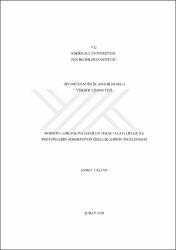Modifiye edilmiş poli (Etilen teraftalat) lifler ile proteinlerin adsorpsiyon özelliklerinin incelenmesi
Özet
Adsorpsiyon işlemi için birçok çalışmada model protein olarak kullanılan Bovin Serum Albumin (BSA) proteini seçilmiştir. İki bölüm halinde gerçekleştirilen çalışmanın birinci bölümünde öncelikle orijinal poli (etilen teraftalat) (PET) lifin adsorpsiyon kapasitesi incelenmiştir. Daha sonra bu liflere glisidil metakrilat (GMA) monomeri değişik aşılama oranlarında aşılanmıştır. Aşılama işlemi sulu ortamda benzoil peroksit (Bz2O2) başlatıcısı kullanılarak yapılmıştır. Polimerizasyon işleminden önce dikloretan (DCE) içerisinde 90 ºC'de 2 saat süre ile şişirilmiştir. Daha sonra liflere uygulanan çeşitli modifikasyon uygulamalarıyla liflerin adsorpsiyon kapasitesi incelenmiş ve maksimum adsorpsiyon kapasitesine sahip PET lif belirlenmiştir. Modifikasyon işlemlerinde hekzametilen diamin (HMDA), etilen diamin (EDA) ve Cu(II) metali kullanılmıştır. İşlemler sonucunda maksimum adsorpsiyon kapasitesine sahip lif olarak Cu-HMDA-GMA-g-PET lif seçilmiştir. Tez çalışmasının ikinci kısmında ise pH, dengeye gelme süresi, sıcaklık ve protein başlangıç konsantrasyonlarının adsorpsiyona etkisi incelenmiştir. Deneyler sonunda optimum pH 5, optimum sıcaklık 45 ºC bulunmuştur. Dengeye ulaşma süresi ise 9 saat olarak tespit edilmiştir. Yapılan desorpsiyon işleminde ise 50 ppm konsantrasyonunda adsorbe edilen proteinin tamamına yakının desorbe oduğu görülmüştür. Yapılan modifikasyon işlemleri ve optimum deney koşullarında gerçekleştirilen deneyde, lifin protein adsorbans yeteneğinin 47 mg/g'a çıktığı belirlenmiştir. For the adsorption process, Bovine Serum Albumin (BSA) was used as a model protein in many studies. In the first part of the study, which was carried out in two parts, the adsorption capacity of the orijinal poly (ethylene terephthalate) (PET) fiber was examined. The glycidyl methacrylate (GMA) monomer was then grafted into these fibers at different grafting rates. Grafting was done using benzoyl peroxide (Bz2O2) initiator in aqueous medium. Before the polymerization process, it was swollen in dichlorethane (DCE) at 90 ºC for 2 hours. Later, the adsorption capacity of the fibers was examined with various modification applications applied to the fibers and PET fiber wtih the maximum adsorption capacity was determined. Hexamethylene diamine (HMDA), ethylene diamine (EDA) and Cu(II) metal were used in the modification processes. As a result of the processes, Cu-HMDA-GMA-g-PET fiber was chosen as the fiber with maximum adsorption capacity. In the second part of the thesis study, the effects of the pH, equilibration time, temperature and protein initial concentrations on adsorption were investigated. At the end of the experiments, optimum pH was 5 and optimum temperature 45 ºC. The time to reach balance was determined as 9 hours. In the desorption process, almost all of the protein adsorbed at 50 ppm concentration was observed to be desorbed. In the experiment carried out under the modification processes and the optimum experimental conditions, it was determined that the protein adsorbance ability of the fiber increased to 47 mg/g.
















